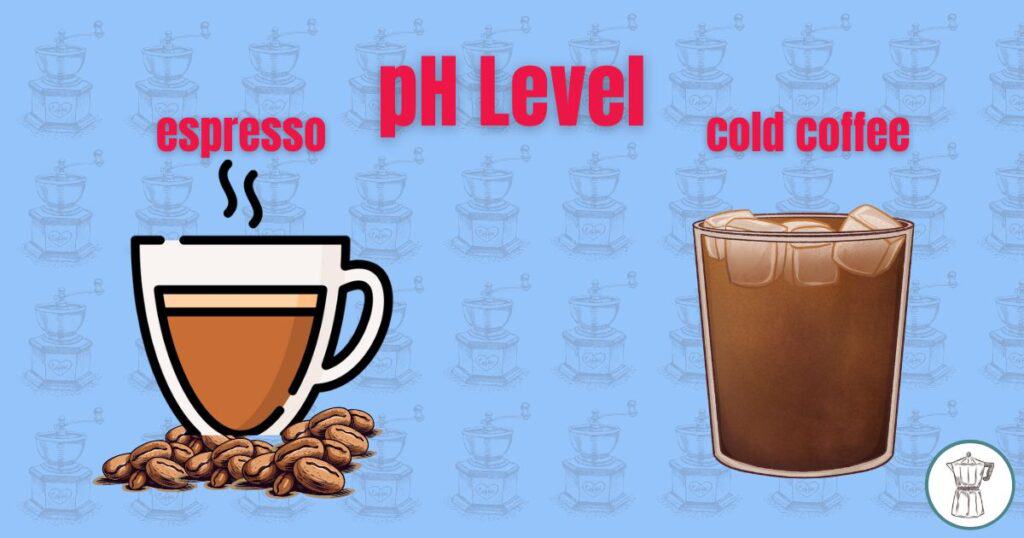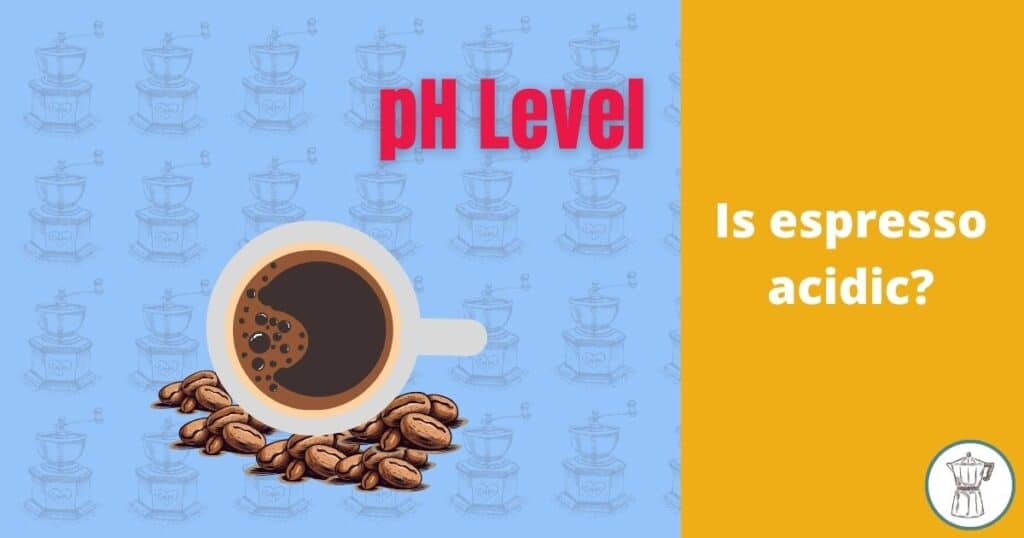A question that often pops into my mind is ‘Is espresso more acidic than other coffees?’
Or is it because it’s sour makes us believe that it’s high in acidity? I have done research and managed to find a bunch of interesting findings and I’m sharing them below along with eight ways to reduce the acidity level in espresso.
Let’s dive in.
Key takeaways:
- What makes espresso acidic
- Is cold espresso less acidic than hot
- How much espresso you can drink if you suffer from acid reflux
Is espresso really acidic?
Yes, espresso is acidic, but the good news is that it’s less acidic than other coffees, making it a great choice for anyone facing stomach issues including gastric ulcer or acid reflux. Because the roasting process lasts long, the acidity levels of espresso decline dramatically, so (as you might have guessed), light and medium roasts are higher in acidity than dark.
Espresso, however, can turn acidic occasionally, a topic I’m going over in the next section.

This is what a coffee expert says about acidic coffee:
Coffee is acidic due to compounds like chlorogenic acid. While its taste may be bitter, it doesn’t determine its acidity or basicity. If you’re sensitive to acidity, consider low-acid coffee varieties. Individual responses vary, so it’s crucial to address your specific situation.
– Kara Gonzales
Can espresso turn acidic?
Interestingly, roasting isn’t the only element that impacts the acidity of espresso.
Here are three more aspects:
- The brewing process also plays a key role; the longer you brew coffee, the less acidic your beverage will be – you can adjust the brewing process when making coffee at home, but you can’t do much when you order an espresso at a coffee bar with a huge queue of customers waiting behind you.
- The origin of the coffee beans makes a whole lot of difference. Robusta and Arabica are the two main categories of coffee beans. Arabica which mainly comes from Ethiopia and it makes up around 60% of the global coffee production, contains citrus notes – giving your espresso a tangy spin – and is higher in acidity than Robusta coffee beans.
- Sugar, cream or any other sugarated sweeteners increase the acidity in your espresso; They not only spoil the unique espresso taste but also have acidic compounds including malic and glyceric acid that add up to the acidity of your cup.
The right pH level for an espresso
As a rule of thumb, a freshly brewed espresso needs to have 4.5 pH which makes it acidic enough to extract all the flavours and aromas from the coffee grounds. To put things in perspective the pH of water is around 7.0, black tea 4.9-5.5 and mint tea 6-7.
When the pH is higher than 4.5:
- It tends to be too bitter.
When the pH is lower than 4.5:
- It lacks aroma and taste

Is espresso way more acidic than cold coffee?
Iced coffee is not only a great way to quench your thirst on a scorching day but it’s also an excellent option if you’re looking for low-acidity coffee. Ice, an indispensable ingredient for cold coffee, prevents brewed coffee from releasing too much acid. Simply put, cold coffee isn’t as acidic as hot.
It’s one more reason to drink cold coffee.
Is espresso better than brewed/regular coffee?
Is espresso more acidic due to its intense taste?
It all boils down to coffee beans; because espresso beans are dark roast, regular coffee is more acidic, and slightly more acidic than espresso (4.5-5.0 vs. 5.5-6.0 respectively). One thing both coffees have in common is that stain your clothes and furniture.
I was thinking of cutting out espresso due to acidity levels, but I need to reconsider things.
Is Nespresso more acidic than espresso and normal coffee?
Nespresso’s pH is around 5.0 which makes it slightly less acidic than espresso, but it’s pretty much as acidic as regular coffee, so these are two options if you’re facing stomach issues.
Can espresso cause you acid reflux?
Food and drinks that contain caffeine including chocolate, tea, and coffee may deteriorate your acid reflux because they make the stomach secrete more gastric acid. If you’ve been suffering from acid reflux for so long now, It’s wise to cut down your coffee intake. But it also depends on the individual and how our bodies react to caffeine.
On a separate note, acidic foods including tomato and orange or lemon juice may also make your acid reflux worse and it’s important to have them in moderation. Also expired coffee tends to be more acidic.
8 ways of reducing the acidity in your espresso
Let’s go over eight different ways to reduce the acidity levels of your espresso.
1. Use coarse grinds
The finer the coffee is ground, the less acidic your brew will be; the surface of the grounds is exposed longer to water and as a result, not many coffee compounds end up in your cup.
2. Go for filtered or bottled water
Did you know that about 97% of a cup of coffee is water?
The water you use to brew your cup of joe impacts the acidity of your beverage; if you live in an area with hard acidic water (high in calcium and magnesium), odds are the acid content of your coffee is going to be high. Why not replace tap water with filtered or bottled?
Your brew’s pH is going to be closer to the ideal, allowing you to enjoy an aromatic cup of coffee that tastes just right.
3. Brew at a lower temperature
Because high temperature makes coffee extract more acid into your cup it’s wise to brew coffee at a slightly lower temperature. As a rule of thumb, the best temperature to make espresso is 94-96℃ (201-204F), but there’s no harm in brewing at 90-94 (194-201F); your drink is going to be less acidic and still taste great. Also being aware of how long an espresso lasts makes you drink it soon after the brewing is done.
4. Some milk?
Similar to water, the pH in milk is around 7.0 and by adding a splash of it to your espresso you’ll neutralise the pH more and enjoy a delicious milky cup of joe, especially if you’re big on coffee with milk this can be your go-to solution to acidic espresso.
5. Switch to decaf coffee
During decaffeination, coffee loses most of its (around 97%) caffeine as well as phenolic acids, making decaf espresso beans a great option for low-acid espresso. Puroast beans are great coffee beans low in acidity.
6. Go for low-acidity coffee beans
As mentioned above the two main coffee bean categories are Arabica and Robusta with the latter being less acidic, so why not go for Robusta coffee beans?
Sumatra coffee beans from Indonesia with an aromatic earthy taste are another great low-acid option worth checking out. And of course, the roast is also important; dark and medium are less acidic than light.
Here’s what a coffee lover has to say about less-acidic coffee beans:
I recently got my first espresso setup, and started dialing in some natural Ethiopian beans and couldn’t figure out if I was doing something wrong or if that’s just how beans are. After pushing a longer ratio I got something drinkable, but lots of acidity is definitely not my thing and I started with some of the most acidic beans it seems. Next was washed Guatemala and that is much more to my taste
– saintmsent
7. Try out a new brewing way
In general dripping coffee machines make a slightly more acidic coffee than coffee machines, so why not swap your dripping coffee maker with a coffee machine?
Coffee made with a French Press is also low-acid; coarse grounds are the best option for brewing with this handy gadget and as mentioned above coarse grounds equal to less acidic coffee.
8. Bake instead
You can switch from brewing to baking; as mentioned earlier roasting coffee reduces its acidity level and in order to reduce it you can use your grinds to make espresso powder which is a great ingredient for delicious, gorgeous cakes.
The table summaries the eight ways to reduce acidity in espresso:
| Way: | Result: |
| Coarse grounds | The coffee you produce is acidic |
| Filtered or bottled water | The water you use for brewing is neutral and less acidic |
| Brew at a lower temperature | High brewing temperature extracts too much acidity from the coffee grounds |
| Coffee with milk | Milk neutralises the pH of your coffee |
| Go for decaf coffee | Decaf coffee is slightly less acidic |
| Opt for low-acidity coffee beans | You’ll make less acidic coffee |
| Find an alternative to an espresso machine | Other methods produce less acidic coffee |
Is instant coffee too acidic?
No, it’s not, it pretty much has as much acid as normal coffee has, and of course, cold instant coffee is less acidic than hot.
Best low and high-acidic coffees
Coffee types grown at relatively low altitudes including Brazilian and Nicaraguan are usually low-acid coffee. On the other hand, coffees cultivated at high altitudes (you guessed it), such as Guatemalan, Kenyan and Costa Rican are high in acid.
Let’s wrap it up
Next time someone asks you if you’re on a diet simply because you take your coffee plain you can just firmly reply that you make the right choices for your health and drink less acidic coffee. Did you know that eating whole coffee beans gives you energy?

- How to Remove Coffee Stains From Countertop The Easy Way - December 21, 2023
- Can You Reuse Coffee Grounds in French Press? Truth Inside - December 12, 2023
- Can Expired Coffee Creamer Make You Sick? 3 Ways to Find Out - December 9, 2023
